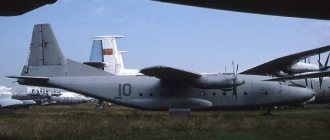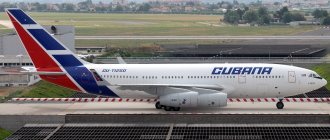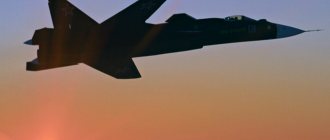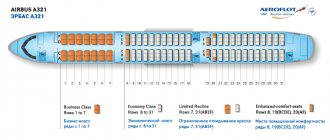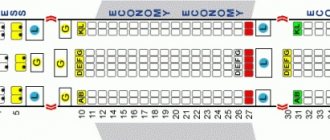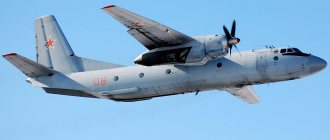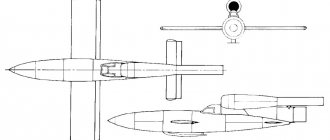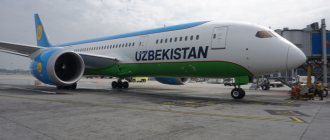| Hongdu L-15 JL-10 | |
| Type | combat training aircraft |
| Developer | Hongdu (HAIG) ZMKB "Progress" Yakovlev Design Bureau |
| Manufacturer | Hongdu (HAIG) |
| Chief designer | Zhang Hong (张弘)[1] |
| First flight | March 13, 2006[2] |
| Start of operation | 2013[3] |
| Status | operated, produced |
| Operators | Chinese Air Force |
| Years of production | since 2010[4] |
| Unit cost | ~10 million (as of 2012)[5] |
| Media files on Wikimedia Commons | |
Hongdu L-15
is a Chinese combat training aircraft developed by Hongdu with the assistance of the Yakovlev Design Bureau[6].
Created to replace the obsolete Hongdu JL-8 combat training aircraft. Designed to train Chinese pilots on the latest Chinese Air Force fighters: Su-30, Shenyang J-11 (a copy of the Su-27), Shenyang J-15 (a copy of the Su-33) and Chengdu J-10.
Adopted by the Chinese Air Force in 2013 under the designation JL-10[3].
History of creation and production[edit | edit code]
The development of the L-15 supersonic combat training aircraft began in the early 2000s. jointly with the Russian Yakovlev Design Bureau and the Ukrainian ZMKB Progress. The Russian design bureau provided technical documentation for the Yak-130 aircraft, and the Ukrainian design bureau supplied DV-2 engines for testing prototypes.[1]
In 2004, the L-15 model was first demonstrated at the Zhuhai Airshow.
In 2006, a prototype aircraft made its first flight.
In 2009, Yuriy Yekhanurov, the Minister of Defense of Ukraine, announced his intention to establish joint production of the L-15 combat training aircraft with Hongdu.[7][8]
In 2010 at the Air Show China 2010
An improved version of the L-15 Lift (Lead in fighter training) was introduced, which made its first flight on October 20, 2010. The modernized version received Ukrainian jet engines with an afterburner AI-222-25F. The Russian Yak-130 is equipped with AI-222-25 power plants (without afterburner).[9] Thanks to modernization, the maneuverability of the L-15 has improved to the level of third-generation fighters, and in terms of climb rate the aircraft is not inferior to the American F-16 and the French Mirage 2000.[9]
On August 15, 2010, Hongdu announced that development of the L-15 aircraft had been completed.[4]
In 2011, Hongdu ordered 250 Ukrainian AI-222-25F engines for L-15 combat trainer aircraft with delivery by 2015.[10]
In 2013, it became known about a long-term contract with Motor Sich dated 2001 for the supply of 1920 AI-222-25F engines and the repair of 3840 units until 2041 for a total amount of $5.7 billion[11].
In 2015, Ukraine made a preliminary agreement with China on the purchase of Hongdu L-15 for the needs of the Ukrainian Air Force. The main condition of the deal is the localization of the assembly of combat vehicles at the Odessa Aviation Plant, whose capacity will be increased with the help of the Chinese side. However, the number of attack aircraft being purchased and the cost of the contract are not reported[12][13].
In 2021, the official publication of the Central Committee of the Communist Party of China, the People's Daily newspaper, reported that aircraft engines for the L-15 would be assembled in China[14].
Hongdu L-15B combat training aircraft (China)
The Chinese aviation industry has once again demonstrated its success. A few days ago, a solemn ceremony was held to roll out the first prototype of the promising Hongdu L-15B aircraft from the assembly shop. This machine represents a further development of one of the existing Chinese aircraft, and in the foreseeable future it may enter service with the Air Force of the People's Liberation Army of China or other countries. In the meantime, the prototype aircraft will have to undergo the necessary tests.
The solemn ceremony of rolling out an experimental vehicle of a new type took place on April 28. The venue for this event was one of the workshops of the aircraft manufacturing plant in Nanchang, part of the Hongdu Aircraft Industry Group (HAIG). The ceremony was attended by government officials, officers and generals of the armed forces, as well as the press. It is interesting that this time the rollout of the prototype aircraft was carried out in a solemn and festive atmosphere. The assembly shop, as well as the area in front of them, were decorated taking into account local traditions. In addition, the “hero of the occasion” in the person of the first experimental L-15B was not left without decorations.
During the ceremony, various speeches were made and some statements were made. In addition, performances by creative groups took place. After this, the first built aircraft of the new type was taken out of the assembly shop to an open area. Now he will have to enter flight tests, the results of which will determine his future fate as a promising multi-purpose aircraft for the air forces of China and foreign countries.
The newest Hongdu L-15B aircraft is a further development of the L-15 combat training vehicle, which has now passed all the necessary tests, been accepted for service and put into production. During the development and improvement of the existing vehicle, some units were replaced, with the help of which, allegedly, it was possible to obtain a noticeable increase in the main technical and combat characteristics. At the same time, the airframe and other on-board systems did not undergo noticeable changes, which led to an increased degree of unification and corresponding operational consequences.
Let us recall that the basic version of the L-15 (or L-15A) training aircraft was created in the first half of the last decade. To develop a new machine, the HAIG industrial group enlisted the support of the Russian Design Bureau named after. A.S. Yakovlev and the Ukrainian enterprise “Progress” named after. A.G. Ivchenko. As part of such cooperation, Russian specialists helped their Chinese colleagues with the development of the airframe and on-board systems, and the task of the Ukrainian enterprise was to produce and supply the required turbojet engines.
By the mid-2000s, such an international consortium had carried out certain work and formed the general appearance of the future aircraft. In 2004, a mock-up of the future L-15 was shown to the general public for the first time. Later, the first prototype was built, which took off for the first time in 2006. Subsequently, all the necessary tests were carried out, according to the results of which the vehicle was recommended for adoption by the PLA Air Force. The training aircraft for China received the official designation JL-10.
Certain features of the development process of the JL-10 / L-15 project and the participation of the Russian design bureau led to the fact that the Chinese aircraft is actually a redesigned version of the existing Yak-130. At the same time, there are some changes in the design and composition of the equipment, due to customer requirements, as well as related to the capabilities of Chinese industry.
The development of a project to modernize the existing aircraft began approximately simultaneously with the adoption of its basic version. In 2010, HAIG first showed an improved version of the machine called L-15 LIFT (Lead-In Fighter Training). This aircraft upgrade project implied the use of a different power plant and more advanced avionics with new capabilities. Subsequently, the development of the project was continued, and has now led to the appearance of the improved L-15B vehicle.
A further development of the Chinese JL-10 and Russian Yak-130, the new L-15B retains a similar airframe design. The same aerodynamic configuration is used with a trapezoidal wing, which has advanced mechanization and front root overhangs covering the air intakes on top. The airframe has a large nose compartment for installing a two-seat tandem cabin. Two turbojet engines are placed in the tail of the vehicle. The layout and equipment of the tail compartment are one of the main differences of the updated vehicle.
An interesting feature of the L-15 family projects, which distinguishes them from the Russian Yak-130 aircraft, is the materials used. Russian designers, based on reasons of maintainability, completely abandoned the use of composite materials and used only light alloys. The Chinese project, in turn, provides for a fairly widespread use of composites. About a quarter of all airframe components are made from such materials, including control surfaces of the wing and tail. A glider of such a mixed design, according to available data, has a service life of 10 thousand hours, which will allow the aircraft to operate for three decades.
One of the main innovations of the L-15B project is the use of two AI-222-25F turbojet engines equipped with an afterburner. These products were developed by the Zaporozhye mechanical engineering design bureau "Progress" and are mass-produced by the Motor Sich enterprise. Unlike the AI-222-25 engine, proposed for use in previous versions of the project, the new AI-222-25F is equipped with an afterburner. This gives a noticeable increase in overall thrust and allows the aircraft to demonstrate higher flight characteristics.
Allegedly, with the help of two engines with afterburner thrust of 420 kgf, the L-15B aircraft is capable of reaching speeds of up to 1,480 km/h. The ability to fly at supersonic speeds is a noticeable advantage over the existing serial modification. It can have a positive impact on the progress of pilot training, and will also have certain positive consequences in the possible combat use of the equipment.
Engines for production aircraft will apparently be supplied by Ukraine. In 2013, it became known about existing and ongoing plans. Thus, from 2001 to 2041, China was supposed to supply 1920 engines of the AI-222-25F type. In addition, there were plans to repair twice as many similar products. At the same time, it cannot be ruled out that in the future the Chinese engine industry will master the independent production of AI-222-25F engines or other products with similar parameters.
The avionics of the updated aircraft comply with the LIFT concept. The machine has a so-called glass cockpit with three multifunctional liquid crystal displays on each pilot's seat. The steering wheels are controlled using an electric remote control system with quadruple redundancy. The power plant is also controlled electronically. The L-15B control system contains devices that allow you to change the characteristics of the aircraft and its control features. Due to this, the machine can imitate various types of aircraft manufactured in China and abroad, which greatly facilitates pilot training.
The JL-10/L-15A trainer aircraft has some potential in terms of combat use, but in such a context its capabilities are limited. As part of the new L-15B project, it was proposed to use some new means to achieve a noticeable increase in combat qualities. As follows from the available data, such goals are achieved with the help of updated detection systems, improved weapons control equipment and increased ammunition.
It is proposed to use a new radar station to monitor the situation, detect targets and use certain types of weapons. According to some reports, a passive phased array antenna should be placed under the radio-transparent nose cone - similar systems are used on various modern combat aircraft. The use of PFAR will make it possible to obtain the maximum possible characteristics while maintaining acceptable dimensions corresponding to the reduced dimensions of the nose of the vehicle. The type and characteristics of the proposed radar have not yet been specified.
Also, an increase in combat characteristics is achieved by increasing the number of external suspension units. HAIG designers managed to place 9 pylons under the wing and fuselage of the aircraft for mounting weapons. There are two more suspension points at the wing tips. According to various data and estimates, after increasing the number of hardpoints and installing new weapons controls, the L-15B aircraft will be able to carry a variety of weapons to attack air and ground targets. First of all, compatibility with Chinese-made products must be ensured. The central ventral pylon can also be used to install a suspended container with an automatic cannon.
The new combat trainer aircraft was presented under the designation Hongdu L-15B, which may indicate its export purpose. The equipment of this family has already managed to interest some foreign customers, but the volume of export supplies is not yet too large. To date, aircraft of the previous modification have been purchased only by the Zambian Air Force. The Chinese-Zambian agreement implied the supply of six vehicles.
In addition, Pakistan and Uruguay showed interest in such equipment, wanting to buy a number of finished Chinese-assembled aircraft. In 2015, the Ukrainian authorities indicated their interest in the L-15. It was assumed that in the future an agreement would emerge, according to which China and Ukraine would establish joint production of aircraft. The final assembly of the vehicles was planned to be organized at the Odessa Aviation Plant. However, Pakistan, Uruguay and Ukraine have not yet signed the required contracts and remain on the list of potential customers.
During the solemn ceremony of rolling out the first experimental L-15B, at least a dozen other aircraft of the previous modification were in the workshop of the Hongdu Aircraft Industry Group and beyond. These machines are at various stages of assembly. Some have not yet received the main units, while others only need to undergo painting. All this shows that the industry continues to fulfill the existing order of the PLA Air Force. Judging by the known data and footage from the assembly shop, in the foreseeable future, Chinese military aviation will have at least 25-30 JL-10 aircraft.
The commercial prospects of the new aircraft are not yet completely clear. An improved version of the existing training machine could indeed be of interest to both China and foreign countries. Thus, it seems very likely that the L-15B, after passing all the necessary tests and inspections, will be adopted by the PLA Air Force. The possibility of supplying such equipment to third countries should also not be excluded. However, the presence of only one export contract for the supply of production L-15A may be a reason for pessimism.
The real prospects of the next Chinese aircraft will be known only in the future, when the newly built prototype has passed all tests and is offered to customers. Apparently, the Chinese Air Force will be the starting customer, while the appearance of other contracts with foreign countries remains in question. However, even in this case, the very existence of the Hongdu L-15B project can show one important fact: now China intends to enter the international market of combat training aircraft and gain a foothold in it.
Based on materials from the sites: https://flightglobal.com/ https://military-today.com/ https://bestchinanews.com/ https://armstrade.org/ https://bmpd.livejournal.com/
Description of the design[edit | edit code]
Hongdu L-15, 2008.
The aircraft uses a quadruple redundant remote control system. A “glass cockpit” is also implemented: there are six multifunctional color displays (three for each pilot).
A collimator indicator is installed in the pilot's cockpit. The dimensions of the aircraft allow it to accommodate a modern radar with AFAR.
The aircraft's structure is 25% made of carbon composite materials, including the tail and flaps. Estimated service life is 10,000 flight hours or 30 years.[5]
The aircraft is equipped with two Ukrainian AI-222-25F turbojet engines with an afterburner and modern on-board equipment, including a digital power plant control system.
World Of Man Dreams
Developer: Hongdu Country: China First flight: 2006 Type: Multi-role combat trainer aircraft
PLA Air Force pilots are trained today in several “air force academies” (as the old pilot schools are now called in the PRC in the “New China” manner). The academic course is designed for two years; during its completion, the cadet acquires about 280-300 hours of flight time. At the final stage, young pilots undergo training on combat trainer aircraft (two-seat versions of combat vehicles) with the development of the basic elements of combat use.
However, the use for in-depth training (as well as “additional training” in the centers) of increasingly complex and expensive combat aircraft and combat training fighters created on their basis is becoming a burdensome task even for a country like the PRC, where they have never saved much on defense: one hour a flight of the same JJ-7 (not to mention the Su-27UB) costs several times more than an hour of flight of a specialized training aircraft. A reasonable way out of this situation is seen in minimizing the use of “large” combat training aircraft and introducing a kind of intermediate stage - a specialized, relatively simple and cheap supersonic control unit, which could be entrusted with a significant part of the tasks that a piston training device is not able to solve .
At the same time, the JL-8 jet is almost entirely exported and is virtually absent from the national air force. The reason for this, apparently, lies in the fact that this generally successful machine, created primarily to meet the requirements of the Pakistani Air Force, which uses a Western flight training scheme, does not quite meet the Chinese requirements for training equipment.
The PLA appears to be in need of a more versatile aircraft capable of supporting both basic and advanced flight training programs. And the latter assumes that the training vehicle has higher flight characteristics, bringing it closer to a supersonic fighter. The creation of such an aircraft began in China at the end of the last decade.
In September 2001, at the Aviation Expo in Beijing, a seemingly unnoticeable event took place: at the stand of the state-owned aircraft manufacturing concern CATIC II, a model of the new generation L-15 training aircraft, developed by HAIC (Hongdu Aviation Industry Group), was exhibited for the first time. part of the state concern AVIC II. The explanatory plate for the model (reproducing the classic appearance of a modern combat training aircraft with a trapezoidal wing, single-tail tail, side air intakes and a cabin canopy “inflated” to a reasonable limit) stated that the machine being created is designed for M=1.4 and is intended for advanced training fighter aircraft pilots, and is also capable of solving certain types of combat missions.
In November 2002, the L-15 model was again demonstrated at the Zhuhai International Air Show among a large number of models of other promising supersonic aircraft. Information about the new car, disseminated during the exhibition, was more detailed than in Beijing. It was announced that the aircraft would receive two Ukrainian AI-25 type engines or Chinese advanced WS11 engines (2×3500 kgf), a digital multi-channel fly-by-wire control system, a modern cockpit information and control field made using multifunctional color liquid crystal displays, control levers , meeting the requirements of the HOTAS concept (piloting without taking your hands off the stick and throttle), an automatic weapon release control system.
In August of the following year, during the Moscow Aviation and Space Salon MAKS-2003, at a briefing held by Yakovlev’s company, its General Director Oleg Demchenko announced joint work between the Yak Design Bureau and the Chinese corporation AVIC II on a “promising supersonic training by plane." According to Demchenko, the project was based on the Chinese concept of training equipment, known as “L-15”.
A little later, Oleg Demchenko reported that the Russian company, commissioned by the Chinese corporation AVIC II, provided consultations and “prepared an engineering note on the L-15 concept.” According to the general director of Yak, the Chinese were provided with assistance in evaluating the concept of a supersonic training device, and also provided scientific and technical support for this project.
More detailed information about Russian-Chinese cooperation on the L-15 program was widely discussed in the media. And judging by the current appearance of this aircraft, then the Chinese one has been added to the Italian “clone” of the Yak-130 (M-346 “Master”).
The L-15 prototype, which was given the proud name “Flying Lion,” was rolled out on September 23, 2005, and this machine performed its first test flight on March 13, 2006. By the middle of next year, the prototype had already flown more than 60 hours. The second prototype was sent for statistical testing, and the third aircraft, equipped with a full set of avionics, after its ceremonial presentation at the Zhuhai Air Show in November 2006 (held quite in the American style, with ceremonial speeches, an orchestra, balloons and unnaturally long-legged girls posing on the background of the "Flying Lion"), entered testing at the end of 2007 and made its first flight on May 10, 2008.
It was assumed that the first stage of flight testing would be completed in 2009. According to a number of sources, after this the PLA Air Force must make a choice between the L-15 and another type of promising supersonic training device - the FTC-2000. However, there are reports that back in April 2006, the Chinese Ministry of Defense ordered a pilot series of four L-15 aircraft, the construction of which was to begin in 2007, and the total order of the Chinese Ministry of Defense for aircraft of this type was 200 units. Thus, the L-15 and FCT-2000 aircraft will coexist in the Chinese Air Force in parallel, and the competition between HAIC and GAIC in the field of combat training aircraft, if it exists, is only in the form of the “socialist competition between labor collectives” that we have forgotten.
According to foreign media reports, the cost of one serial “Flying Lion” will be $14.6 million. This is quite a large amount when compared with the cost of previous Chinese serial supersonic aircraft. However, the cost of Chinese 4th generation aircraft, developed with a large percentage of foreign partners and having a significant number of foreign components (which was not the case on aircraft such as the J-6, J-7, J-8 and Q-5, which were entirely produced in China), is gradually approaching the global level and in the foreseeable future, apparently, will cease to be the main trump card of the Chinese aviation industry.
At the exhibition in Zhuhai in 2010, AVIC Corporation demonstrated a new version of the L-15 training vehicle, equipped with uprated Ukrainian-made engines with a FADEC-type control system. In addition, this aircraft is equipped with a radar and advanced instrumentation in the cockpit: HUD and three MFIs (previous versions of the aircraft had two MFIs). Changes were also made to the design of the aircraft - the tail and flaps of the new version are made of CM.
The first flight of this version of the aircraft, designated L-15 Lift, took place on the eve of the exhibition - October 29, 2010.
Afterburning engines provide the L-15 Lift with a thrust-to-weight ratio close to 1 and make it possible to develop supersonic speed. According to the aircraft's developers, the rate of climb and maneuverability characteristics of the new version of the training device are comparable to the corresponding parameters of the F-16 and Mirage 2000 fighters. If there are orders for the L-15 Lift aircraft, it may appear on the market in two years and compete with the Russian Yak-130 trainer and the South Korean T-50 trainer.
The first foreign debut of the L-15 took place at the MAKS-2009 air show, held in Zhukovsky near Moscow. And one of the first foreign buyers of the “Flying Lion” will quite possibly be Ukraine. Currently, the Ministry of Defense of this country is studying the possibility of producing the L-15 aircraft jointly with China (in fact, this UBS, which has Ukrainian engines, is already in some way Chinese-Ukrainian). This prospect was recently announced by Defense Minister Yuriy Yekhanurov, who has now been relieved of his post, summing up the results of the five-day visit of the Ukrainian military delegation to the People's Republic of China: “We have sufficient capacity in the Ministry of Defense to implement such projects. Now we will study the technological capabilities of our aircraft repair enterprises and will conduct a specific negotiation process with representatives of China from the point of view of the possible production of such combat training aircraft. This is a very serious topic."
Speaking about the prospects for Kiev’s participation in the Chinese UBS program, it should be recalled that, having become “independent”, Ukraine has already made attempts to create an aircraft of its own design that is similar in its characteristics and combat capabilities: in the 1990s, it began the development of an aviation complex called “front-line” subsonic vinishuvach-perekhopshchik" (front-line subsonic fighter-interceptor). Actually, initially there were plans to create not a subsonic, but a full-fledged supersonic combat aircraft, however, when using engines of the AI-25 family produced in Ukraine, it was possible to implement only a subsonic or transonic aircraft, and the development of new “engines” or their purchase abroad deemed inappropriate.
Several layouts of such an aircraft were being studied (including very exotic ones, with a forward-swept wing). Work apparently continued until the end of the 1990s, and then was stopped, most likely for financial reasons. Now the “niche” in the Ukrainian Air Force, previously allocated to the “shopper,” can be occupied by the Chinese aviation complex, which, in addition to training, should also solve combat missions quite effectively.
Brief description of the L-15 aircraft.
The L-15 combat training aircraft is designed for advanced and (partially) basic training of front-line aviation pilots, as well as for combat missions during conflicts of limited intensity. It is made according to a normal aerodynamic design with a mid-mounted trapezoidal wing with developed root swells, an all-moving trapezoidal horizontal tail and a swept single-fin vertical tail. The aerodynamic configuration of the aircraft provides the ability to perform stable flight at large (up to 30 degrees) angles of attack.
The wing has a vortex-generating “fang” on the leading edge and is equipped with a two-section slat and flap. Unlike the Yak-130, the trailing edge of the wing is not straight, but has a reverse sweep. The airframe of the aircraft is made mainly of aluminum alloys. Its design life is 10,000 hours (which corresponds to 30 years of operation).
The horizontal all-moving tail has a small negative V. The vertical tail is equipped with a single-section rudder. On the upper surface of the fuselage there is an air brake of a relatively large area. The aircraft is equipped with a quadruple redundant digital emulsion system, providing yaw, pitch and roll control.
The first experimental L-15 aircraft was equipped with two Ukrainian Progress/ZMKB DV-2S turbofan engines (2×2200 kgf), providing the ability to fly only at subsonic speeds. The second experimental UBS, as well as production vehicles, are equipped with engines from the same company AI-222-25F (2500/4200 kgf) with an afterburner, allowing (according to calculations) to reach a speed in horizontal flight corresponding to M = 1.4.
The use of larger (length 3138 mm versus 2100 mm for the AI-222-25) and heavier (560 kg versus 350 kg) engines also determined the difference in the design of the rear fuselage of the L-15 from the Yak-130 aircraft. According to the Chairman of the Board of Directors of Motor Sich OJSC Vyacheslav Boguslaev, said in January 2008, Ukraine supplied China with about 20 AI-222-25F engines intended for experimental and first production L-15 aircraft. It should be said that the Motor-Sich AI-25TLK engines, which are structurally similar to the AI-222-25, have been in operation in China and other countries on JL-8 aircraft for almost 15 years, so the development of the “related” AI-222-25F turbofan engines, according to - apparently, will not present any difficulties for the Chinese.
The information and control field of the L-15 aircraft cockpits fully meets the requirements for the “4+” generation. The forward pilot has a wide-angle head-up display (HUD). On the dashboard of each cabin there are two full-color liquid crystal MFIs measuring 5x5 inches. The control levers comply with the requirements of the HOT AS concept.
Although there is no information about the presence of a radar station on board the L-15, the size and shape of the forward part of the fuselage makes it possible to place there a small radar system such as the Russian multifunctional stations “Osa” or “Kopye”.
The aircraft is equipped with Chinese-made ejection seats, which provide the ability to leave the aircraft while parked. However, the export versions will probably also include the use of foreign catapults. Ejection is carried out through a destructible cockpit canopy.
The armament of the L-15 aircraft is located on two end wing and four underwing hardpoints. Its weight reaches 1000 kg. The armament includes short-range air-to-air missiles with PL-9C or TL-10A TGS, placed on the wing tip launchers, as well as unguided weapons (NARS, free-fall bombs, disposable cluster bombs, etc.) on underwing nodes. It can be assumed that a container with cannon armament is provided under the fuselage.
| Modification | L-15 |
| Wingspan, m | 8.73 |
| Aircraft length, m | 12.08 |
| Aircraft height, m | 4.41 |
| Weight, kg | |
| empty plane | |
| normal takeoff | 6500 |
| maximum takeoff | 9500 |
| engine's type | 2 WS-11 turbofans |
| Thrust kgf | 2 x 3500 |
| Maximum speed, km/h | 1486 (M=1.4) |
| Ferry range, km | 3000 |
| Combat radius, km | 550 |
| Maximum rate of climb, m/min | 9000 |
| Practical ceiling, m | 16000 |
| Max. operational overload | 8 |
| Crew, people | 2 |
| Weapons: | one 23-mm cannon combat load - 1000 kg on 5 hardpoints |
Flight characteristics[edit | edit code]
Data source: [3][6][15][16]
Specifications
- Crew: 1 or 2 people
- Length: 12.27 m
- Wingspan: 9.48 m
- Height: 4.81 m
- Empty weight: 4960 kg
- Normal take-off weight: 6500 kg
- Maximum take-off weight: 9500 kg
- Powerplant: 2 × AI-222-25F turbofan engine Afterburning thrust: 2 × 2500 kgf
- Afterburner thrust: 2 × 4200 kgf
Flight characteristics
- Maximum speed: 1479 km/h (=1.4)
- Combat radius: 550 km
- Ferry range: 3100 km
- Service ceiling: 16,500 m
- Rate of climb: 150 m/s
- Maximum operational overload:
+8/-3 g
Armament
- Combat load: 3000 kg on 6 hardpoints (4 under the wing and one each at the tips)
- Guided missiles: short-range air-to-air missiles
- Unguided rockets: blocks with unguided rockets
- Bombs: adjustable and regular bombs
Comparison with analogues[edit | edit code]
| Yak-130[17] | Aermacchi M-346[18] | BAE Hawk T2 (Mk. 128) LIFT[19] | Hongdu L-15 [3][20] | Aero L-159 ALCA[21] | KAI T-50 Golden Eagle[22] | |
| Appearance | ||||||
| Unit cost, $ | ~15 million (for export) | ~30-35 million | 29-33 million | ~10 million | 10-12 million | ~25 million |
| Adopted, year | 2010 | 2011 | 2009 | 2013 | 2001 | 2007 |
| Years of production | since 2009 | since 2010 | n/a | since 2012 | 1997—2003 | since 2005 |
| Wingspan, m | 9,84 | 9,72 | 9,94 | 9,48 | 9,54 | 9,45 |
| Length, m | 11,24 | 11,49 | 12,43 | 12,27 | 12,72 | 13,14 |
| Empty weight, kg | 4600 | 4600 | 4480 | 4960 | 4350 | 6354 |
| Max. take-off weight, kg | 10 290 | 10 200 | 9100 | 9500 | 8000 | 12 300 |
| Combat load, kg | 3000 | 3000 | 3000 | 3000 | 2700 | 3740 |
| Practical ceiling, m | 12 500 | 13 700 | 13 500 | 16 000 | 13 200 | 14 630 |
| Max. speed, km/h | 1050 | 1060 | 1030 | 1479 | 936 | 1640 |
| Range without PTB, km | 2000 | 2000 | 2500 | 3100 | 1600 | 1851 |
| Engine | 2 × AI-222-25 turbojet engine | 2 × Honeywell/ITEC F124-GA-200 turbojet engines | 1 × Rolls-Royce Adour Mk. 951 | 2 × AI-222-25F turbojet engines | 1 × Honeywell F124-GA-100 turbojet engine | 1 × General Electric F404 turbojet engine |
| Max. engine thrust, kN | 2 × 24,7 | 2 × 27,8 | 1 × 29,0 | 2 × 24,7 (41,2) | 1 × 28,2 | 1 × 53,07 (78,7) |
Tender for a new UBS for the Chinese Air Force[edit | edit code]
Hongdu L-15 and Guizhou JL-9 participated in a tender for the supply of new generation combat training aircraft for the training of Chinese Air Force pilots. The Guizhou JL-9 is based on the combat training modification of the Chengdu J-7 (a Chinese copy of the MiG-21).
Compared to the L-15, the JL-9 is equipped with a single engine and generally has a simpler design and is cheaper to manufacture, but does not have significant advantages over the combat training version of the Chengdu J-7 and is, in fact, only an improved version of the obsolete aircraft of the previous generation.
Export[edit | edit code]
On May 1, 2012, Yang Liping, chief economist of Hongdu Aviation Industry Group, announced contracts for the supply of L-15s to Latin America and Africa. In 2012, it was planned to deliver at least 12 L-15s to foreign customers[23][24].
At the end of 2014, Ukraine began to consider the possibility of purchasing or licensed production of Chinese L-15 light attack aircraft[25]. However (as of July 2021) a final decision on this matter has not been made.
L 15-15
Reinforced concrete trays L 15-15 for heating mains are a prefabricated open structure with a bottom and two sides located opposite each other, the cross-section of the tray is made in the shape of the letter “P” or “U” with rounded corners. A floor slab is installed on top of the tray to provide access to the contents of the tray, additionally ensuring the tightness of the structure, protecting the contents from moisture. This solution makes it possible to simplify the maintenance and repair of pipeline systems - in order to get into the pipeline compartment required for inspection or repair, it is enough to dismantle the plate. Also, in the construction of heating mains, the slab does not allow air to leave the tray, retaining heat.Reinforced concrete trays L 15-15 for heating mains are structures that are completely ready for installation in the ground. The technology for laying trays is quite simple: the products are placed in a pre-prepared earthen trench, which is a dug trench (in the case where construction is planned at a facility located on soft soils, the earthen trench is filled with a sand cushion or a special concrete cushion is installed), reinforced concrete slabs are mounted on top ceilings The following design option is also possible: first the slabs are laid, then the trays are installed on them upside down.
Reinforced concrete trays L 15-15 for heating mains are one of the most functionally necessary components in construction when laying heating mains, electrical and other types of wiring in conditions in which the communications are threatened by mechanical damage during operation. Simplicity of design, ease of maintenance and durability of trays are just a few reasons that indicate the advisability of using reinforced concrete products. Concrete trays are equipped with high-strength steel, which allows the products to withstand significant loads and maintain their original properties throughout the entire period of operation. The surface of the trays is covered with special water-repellent and anti-corrosion mixtures. One of the main advantages can also be called the low cost of raw materials, which, taking into account the durability of structures, significantly reduces construction costs.
Trays L 15-15 for heating mains are made only from heavy concrete with compressive strength classes B15, B25, B30 and B35. The class of concrete for frost resistance and water resistance depends on the hydrogeological conditions of the proposed construction site, as a rule, from F50 and W2, respectively. To increase durability and wear resistance to aggressive environments, concrete for trays is treated with polymer compounds. The trays are reinforced with welded frames and meshes made of steel of classes A-I, A-III and BpI. Depending on the projected load, hot-rolled or prestressed steel is prepared. All metal elements additionally undergo anti-corrosion treatment.
Reinforced concrete trays L 15-15 for heating mains are concreted in a horizontal position with the walls down. To remove formwork products from the walls of the trays, formwork slopes are provided at a minimum of 1/15 from the vertical axis. Mounting loops are provided for slinging the trays when removing them from the formwork. The trays are removed from the formwork after the concrete reaches 70% of its design strength.
Trays L 15-15 for heating mains are tested for strength using a non-destructive method in accordance with GOST 8829-85 “Methods for testing and assessing strength, rigidity and crack resistance”. To ensure reliable joining of the tray and the slab, the following conditions must be observed: the maximum permitted deviation of the straightness of the profile over the entire surface of the product should be no more than 8-10 mm. In this case, exposure of the reinforcement is strictly prohibited. Sinks, depressions and sagging on the surface of products should not exceed 3-6 mm in diameter.
Reinforced concrete trays L 15-15 for heating mains must be stored in stacks. The height of the stack is determined from the condition of ensuring safety requirements and in accordance with SNiP III-4-80 “Safety in Construction” and should be no more than 2.5 m. Wooden spacers with a thickness of at least 3 cm are required to be installed at the same distances from the ends of the elements , as the mounting loops, as well as in the places where the ribs of the trays join.
During transportation, trays L 15-15 for heating mains must be securely fastened and have supports located in the same way as during storage. The maximum load in one machine should not exceed 240-350 pieces. When loading and unloading, dumping trays and their further pile-up is not allowed.
You can not only order trays L 15-15 for heating mains, but also consult with our specialists and select the required designs of reinforced concrete products. In our sales department you can find out in advance to clarify the price of reinforced concrete trays and calculate the total cost of the order. You can buy reinforced concrete trays and consult on general issues of purchase and delivery by calling the BLOK Group company: St. Petersburg , Moscow: (495) 646-38-32 , Krasnodar: (861) 279-36-00 . Company operating hours: Mon-Fri from 9-00 to 18-00. GC "BLOK" delivers reinforced concrete trays throughout Russia directly to the customer's site or to the construction site, if the infrastructure allows.
For questions regarding the installation of reinforced concrete trays L 15-15 for heating mains, please call
Notes[edit | edit code]
- ↑ 12
China tested a supersonic combat trainer - PLAAF orders Hongdu's L15 trainer
- ↑ 12345
Hongdu L-15 Falcon - ↑ 12
China began small-scale production of L-15 training aircraft - ↑ 12
Ukraine is preparing to transfer the first batch of serial engines for UBS L-15 to China - ↑ 12
Ukraine is preparing to transfer the first batch of serial engines for UBS L-15 to China - Ukraine intends to start production of multi-purpose aircraft with China
- "Falcons" in Kiev
- ↑ 12
China showed an improved version of the L-15 training aircraft - Ukraine Wins Engine Contract for Chinese L-15 Jet Trainer Production
- Motor Sich will supply China with engines worth $5.7 billion over 40 years
- Ukraine has agreed with China on the purchase of attack aircraft for the Armed Forces of Ukraine, which will be assembled in Odessa - media (unspecified)
(inaccessible link). rus.newsru.ua. Retrieved November 17, 2015. Archived November 17, 2015. - The Odessa plant will assemble Chinese light attack aircraft for the Ukrainian Air Force
- Ukrainian news: China is buying up Ukrainian aviation on the vine - Free Press - Ukraine. News of Ukraine today. What will happen to Ukraine?
- L-15 Advanced Jet Trainer Archived July 6, 2010.
- AI-222-25F
- Yak-130 program Archived November 5, 2013.
- M-346 on the manufacturer's website Archived June 6, 2014.
- Hawk Mk127 / Mk128 LIFT Lead-In Fighter Trainer, United Kingdom
- Hongdu L-15 Supersonic Trainer / Attack Aircraft, China
- L-159 Combat & Training System Archived July 19, 2011.
- T-50 Golden Eagle, South Korea
- L-15″猎鹰»高教机获12架订单单价8000万元 (图)
- China will supply 12 supersonic training equipment L-15 for export
- Ukraine is interested in localizing Chinese L-15 aircraft
- Some details of the sale of the L-15 UBS to the Zambian Air Force have become known
- Chinese light combat aircraft L-15B
- 俄媒称中国已开始向委内瑞拉出口L-15教练机
- Has Venezuela made a choice in favor of purchasing Chinese L-15 Falcon combat trainer aircraft?
- Venezuela is negotiating the purchase of a large batch of Chinese L-15 aircraft
A new combat training aircraft L-15B was presented in China
China presented a new light combat (combat training) aircraft L-15B, which is a modified version of the L-15 (JL-10) combat trainer aircraft. The display and flights of the aircraft took place on November 2 at the flight conference of the Chinese aircraft industry group Hongdu Aircraft Industry Group (HAIG), which takes place in Nanchang.
Image source: topwar.ru
Chinese aviation industry group HAIG has unveiled a new light combat aircraft, the L-15B, developed from the HAIG-produced L-15 (JL-10) combat trainer aircraft. In turn, the L-15 (or L-15A) aircraft was created with the help of the Russian Design Bureau named after. A.S. Yakovlev and the Ukrainian enterprise “Progress” named after. A.G. Ivchenko. As part of such cooperation, Russian specialists helped their Chinese colleagues with the development of the airframe and on-board systems, and the task of the Ukrainian enterprise was to produce and supply the required turbojet engines.
Image source: topwar.ru
The two-seat L-15B is reportedly designed for use as a light fighter-attack aircraft and transitional combat trainer. The rollout of a prototype aircraft took place on May 3, 2021 in one of the workshops of the aircraft manufacturing plant in Nanchang.
As a further development of the Chinese JL-10 (L-15) and Russian Yak-130, the new L-15B retains a similar airframe design. At the same time, instead of the AI-222-25 non-afterburning engines developed by the Zaporozhye design bureau "Ivchenko-Progress", it is equipped with AI-222-25F engines with an afterburner, produced at the Ukrainian "Motor-Sich". Allegedly, with the help of two engines with afterburner thrust of 420 kgf, the L-15B aircraft is capable of reaching speeds of up to 1,480 km/h.
The new aircraft has 11 hardpoints for weapons. HAIG designers managed to place 9 pylons under the wing and fuselage of the aircraft for mounting weapons, and two more suspension points are available at the wingtips. The aircraft is equipped with a weapons control system, including guided weapons. The central ventral pylon can also be used to install a suspended container with an automatic cannon.
The L-15B is equipped with a passive phased array radar. The type and characteristics of the installed radar have not yet been announced.
It is expected that poorer countries in need of inexpensive jet light attack aircraft will show interest in this aircraft, and it is also possible that the L-15B will be adopted by the PLA Air Force as a combat training aircraft. Previously, Pakistan, Uruguay and Ukraine showed interest in the aircraft. There is no data on the conclusion of supply contracts.


